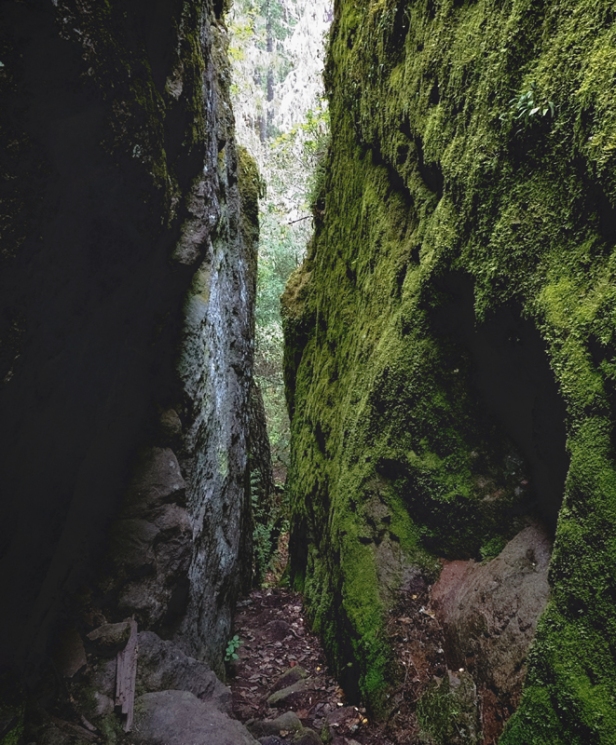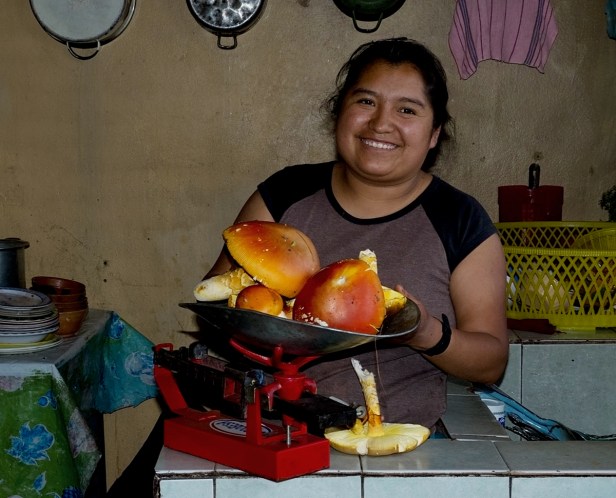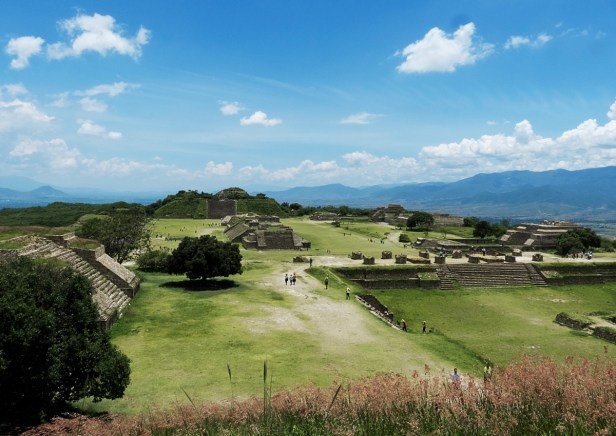20 July – 6 Aug 2013. There are mountains in the state of Oaxaca. Most of the state is mountainous, with one main central valley, and a few smaller valleys. Our hike in the Sierra Norte area began from the town of Cuajimoloyos, about two hours from the city, and our first experience on getting out of the car when we arrived there was shock at the cold. We’d been in the tropics for so long, and also really had no idea how high we’d be going. We were so under dressed. A couple of thin cotton layers weren’t going to do it. At least I had long pants on. Don had worn shorts. Fortunately one of our guides had a jacket to lend Don. I just hugged myself and hoped that I’d warm up as we hiked.
We went as high as 3200 metres (10,400ft) through beautiful countryside with our guides Eric and Iban. Eric was born and raised in the Oaxacan town of Tlacolula, though he’d lived in California for fifteen years and spoke fluent English. Iban was from Cuajimoloyas and was performing community service guiding us on our trek in the mountains.

Initially Don had some trouble with the altitude. We were already at 3160 metres and he thought he wasn’t even going to make it out of town.
Dizzy, lightheaded, rapid heartbeat.
Scary.
So we went slow for the first hour or so.
Stopping. Breathing. Head bent over, hands on knees.
Inhaling. Okay now. Moving on again.
Then things shifted.
Acceptance of whatever is being offered in each moment.
Resistance fell away like the mountains around us.
The weather warmed up,
we warmed up,
and we both got into our stride
lost in joy to the rhythm of our moving bodies,
inhaling the beauty around us.
It was relatively easy pathways until we got deeper into the wilderness and into Coyote Canyon.

We climbed high to sit atop a rocky crag taking in the surrounding view and then had to straddle a long rock, like riding a horse, the canyon deep below us on either side, scooting our buts along to a small suspect bamboo bridge that brought us, finally, back onto a path.
We were agape at the enormous size of the agave plants (for some reason Don decided to try eating one)
and the beauty of the wild flowers
From Iban we learned: take the leaves of a wild plant, wrap them around a hot rock, and pour on water. Women having trouble producing milk breathe in the resulting steam and allow it to cover their breasts. Heat the healing sap from a tree until it liquefies, dip in strips of cloth and wrap it around a broken limb to form a cast that sets hard: just two of the many remedies from the forest.
From Eric we learned: Every adult in the village (and in many of the other mountain villages) does community service. The commitment to a particular service may be one or two or three years according to the type of service. Service is performed every two or three years, again according to the type of service. Being mayor of the village is done as a service to the community, though one has to work one’s way up to this position. Other forms of community service include providing daily lunches for the children at the school, cleaning the town, policing, and guiding hikers on treks over the mountain trails. In this way the community cares for itself, everyone contributing for the good of everyone. Most people of the villages are farmers, the main crops being corn, potatoes and flowers.
At the end of our hike we had a late lunch at the village co-op restaurant. There is a lottery every one or two years. All families who wish to run the restaurant enter the lottery. It’s a lucrative business as buses going through the town always stop there, though it is also a non-stop occupation as the restaurant is open from 6am until 11pm. All the family is involved. No time to rest. A year or two to make some extra income. A huge opportunity.
It was mushroom season and we were hoping for fresh mushrooms. Alas they had none, but the word went out and within ten minutes or so a couple of teenagers entered, each with a bucket filled to the brim with fresh mushrooms, two different kinds. The young women made a delicious mushroom soup, followed by fried potatoes, refried beans and the second kind of mushrooms in a tomato-onion sauce. Very good. Sometimes, often actually, the most down-home places produce the best meals.
The open kitchen of the restaurant, with seating at the other end of the same room. Cooking is done on this huge wood stove and the smaller gas stove against the wall on the left.
The village of Tlacolula is a short distance from the city of Oaxaca and has a large market every weekend including a sale yard for large animals (cattle, oxen, horses and donkeys), and another one for small animals (sheep, goats and pigs). What a feast for the senses it all was.

The tuk-tuk driver taking us from the animal market to the regular market was word-slurring drunk at ten in the morning, very entertaining, and fortunately drove very slowly. We were only mildly concerned. He didn’t hit anything and we arrived safely to dive into the madness and mayhem of the biggest indigenous market in Oaxaca. Apparently you can buy just about anything there, including intestines.







Now we know who does all that exquisite embroidery – while sitting with the ladies selling vegetables
Monte Alban, the ancient capital of the Zapotecs was one of the first cities in Mesoamerica. Founded in 500 BC it was the most important socio-political and economic centre for about one thousand years. The ancient Zapotec name of the city is not known. We climbed and walked all over it, excited and awe struck and full of joy and curiosity. We’d seen pictures, but the real thing is so much more – the scale, the detail, the creativity, the ingenuity.
From Don: Wow, and wow again. Monte Alban was better than I could have possibly imagined. From the bus trip taking us up and up a winding road high above Oaxaca to the entrance to Monte Alban, to the fantastic ruins, it was a treat for the eyes. We began by sitting out on the deck of the pretty café in the museum building having a café Americano (Ali) and a chocolate con leche (me), and then made our way up to the ruins. There were many steep stairs to climb to get an overview of the site, but the climb was well worth it.



Later that day, from Don: After we got back to town I headed over to Supermercado Soriana to get black tea and real vanilla essence, while Ali went clothes shopping. We agreed to meet up at the café on the corner near our apartment. I had no luck finding vanilla or black tea and was at the café before Alison got there. I hadn’t been there more than five minutes when my mind began worrying about what I’d do if Alison failed to show up and I had to try to find her. I began writing to clarify what was going on in my mind: “What happens, happens: worrying about what might happen, or about what might have happened, has only one outcome – unnecessary stress and/or distress. The mind would have me believe that worrying about an undesired outcome makes that outcome less likely to happen: I choose to no longer believe that.” And when I looked down the street as I was finishing writing I saw Ali coming towards me. I still think that it would be a good idea to begin carrying our Vancouver cell phones with us and turn them on whenever we might be apart for a while.
After three spectacular weeks in Oaxaca we boarded one of Mexico’s fabulous luxury buses for the six hour ride to Mexico City. Shamans at the Zocalo, a museum of folk art, a boat cruise with Mariachi bands, Edward Scissor Hands, archeological ruins bigger and better even than Monte Alban, and some pretty unique street scenes – all coming up.
All words and images by Alison Louise Armstrong unless otherwise noted.
© Alison Louise Armstrong and Adventures in Wonderland – a pilgrimage of the heart, 2010-2015.

Love the leave eater photo 😀 and the garlic headdress and, and, and 😀
LikeLike
Thanks Angie. I love the leaf-eater photo too. Don was just fooling of course. I don’t know what got into him, but suddenly he was pretending to chew on an enormous cactus. It’s a strange world 😀
Oh, and the garlic (onion?) headdress! I couldn’t believe it, but there it was in front of me. In most third world countries people (women mostly) carry things on their head, but this sure was the first time I’d seen onions lol!
LikeLike
gorgeousness!!
LikeLike
Thanks Cindy 🙂
LikeLike
Love your writing and photos. I feel like an armchair traveler. As a widow, will I ever get out there alone and travel the world? I’ve done and seen a lot in my lifetime. Thanks for inspiring me to do more.
LikeLike
Hi Sueann, nice to meet you, and thanks for following. I hope you enjoy the stories of our journey. I love that you feel like an armchair traveller – it’s very encouraging.
Go travelling! We met a woman in her 80’s travelling alone in Burma. I think it’s possible to do it and be safe, but part of making it safe is that it can be a bit more expensive.Everywhere we’ve been, staying in 3 star hotels, and sometimes renting apartments there have been good people to help us. You have to take regular precautions but our experience has been positive. I know a woman in her late 60’s who recently spent 5 weeks travelling alone in India. You always meet people along the way.
Thanks for your kind words.
Cheers
Alison
LikeLike
Such wonderful photos (as always); love all the colors, and the people shots.
LikeLike
Thanks Angeline
xox
LikeLike
Beautiful!
LikeLike
Thanks Cora 🙂
LikeLike
First off, those are great photos of the people and the market. You really did a great job of capturing the scene and the people. Second – that agave is huge! I had no idea that got that big. I’ll have to add this hike to our itinerary. Thanks for sharing.
LikeLiked by 1 person
Thanks Jeff. The market was a lot of fun – exotic sensory overload! I had no idea about the agave either, and there was many of them. We booked the hike in Oaxaca – I’ll see if I can find out who with – Don might know.
Alison
LikeLike
We went with Tierraventura – http://www.tierraventura.com
LikeLike
Thanks for the info. I think that is a special kind of dedication to community that the people volunteer.
LikeLiked by 1 person